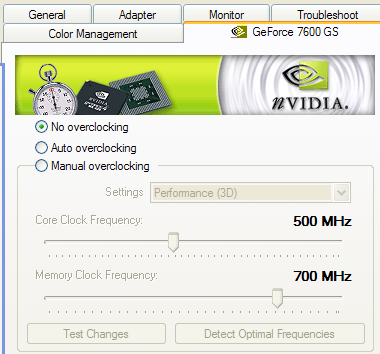System Setup and Notes
We compare the Galaxy GeForce 7600 GS 256 GDDR3 to a 7600 GS running at stock 400/400 clocks, a reference NVIDIA 7600 GT and an ATI Radeon X1800 GTO. The reference 7600 GS obviously sits underneath this Galaxy version in performance, so we use it to show you what their version is buying you. GeForce 7600 GT and ATI Radeon X1800 GTO are the step-up comparisons that sit just above GeForce 7600 GS in priceHardware
|
||
|---|---|---|
| Processor(s) | AMD Athlon 64 FX-60 2.6GHz, dual-core, 1MiB L2 per core, Toledo |
|
| Mainboard(s) | ASUS A8R32-MVP ATI RD580 Crossfire ULi M1575 |
ASUS A8N32-SLI nForce4 SLI x16 AMD |
| Memory | 2 x 512MiB G.Skill F1-3200DSU2-1GBLE | |
| Memory Timings | 2.0-2-2-5 @ 400MHz, 1T | |
| BIOS Version | 0404 | 1103 |
| Disk Drive | 80GB Western Digital PATA | |
| Graphics Card(s) | Sapphire Radeon X1800 GTO (500/500) | Galaxy GeForce 7600 GS 256 GDDR3 (500/700) NVIDIA GeForce 7600 GT (560/700) NVIDIA GeForce 7600 GS (400/400) |
| Graphics Driver | CATALYST 6.4 WHQL | ForceWare 84.21 WHQL |
| Operating System | Windows XP Professional, SP2, 32-bit | |
| Core Logic Driver(s) | ULi M1575 Chipset Driver V1.0.5.2a | nForce4 AMD/Intel x16 6.85 |
Software
|
|---|
|
[advert]
Notes
Our current retail test suite gets one of its final runouts before we switch things around a bit after Computex.Driver defaults were used throughout, and stock clocks were used for all cards. If in-game controls could be used for both antialiasing and anisotropic texture filtering, they were, otherwise the driver was used to force the required levels (if applicable and the game allowed it without rendering errors). Tested resolutions were 1600x1200 and 1920x1200.
Game tests were run a minimum of three times at each setting, and the median value reported. In the case of manual 'run-through' testing with FRAPS, three consecutive runs that produced repeatable results, after further analysis, were used. If values weren't part of a repeatable set, they were discarded and obtained again.
If you have any questions about our testing methods, please feel free to ask at any time in the HEXUS.community. We are well aware that the suite is becoming a little long in the tooth these days (not least of which is the absence of the mighty Oblivion) and we're shifting suite soon, so bear with us while we make that happen.










